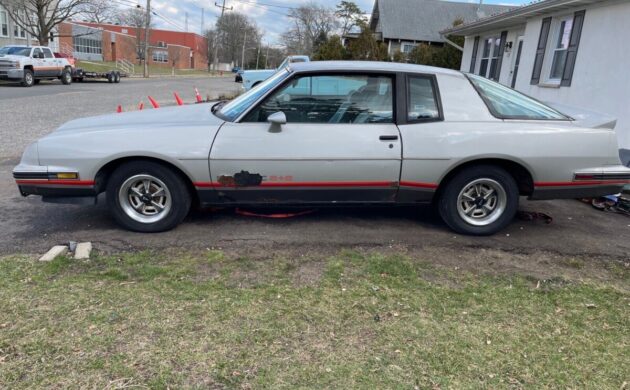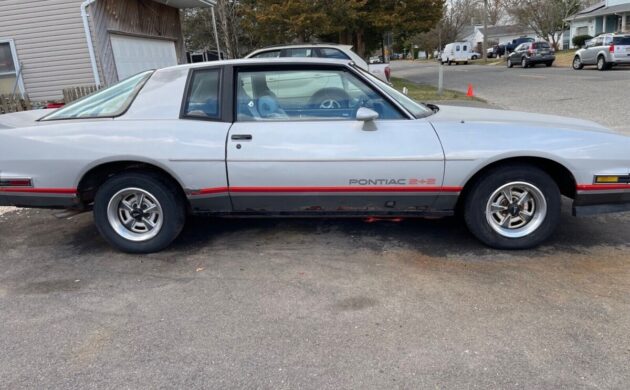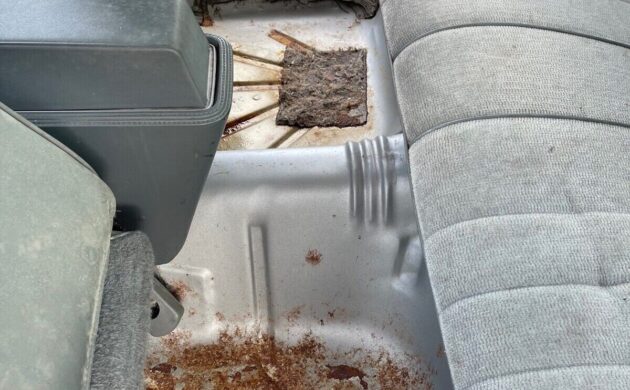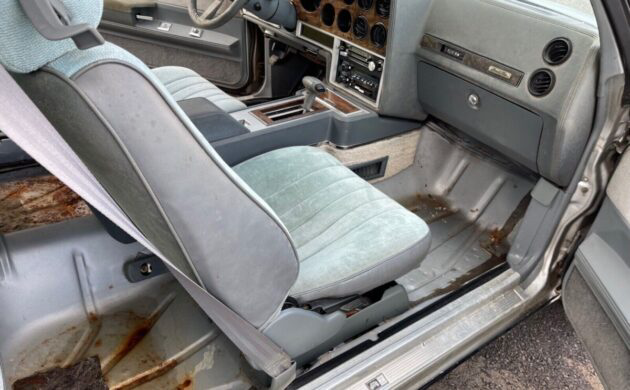Life in NASCAR is very much an action-reaction kind of existence. To achieve what the bigwigs in Daytona call parity, rules are bent, massaged, and sometimes overlooked to make sure the show is a good one. Take for example what happened when Ford’s sleek new Thunderbird began dominating superspeedways in 1984 and 1985. GM executives leaned on NASCAR for an intervention. That intervention resulted in a limited number of modified cars like this 1986 Pontiac Grand Prix 2+2 for sale on eBay in Ocean Gate, New Jersey. While this slope-backed Pontiac is a bit rough around the edges, it represents a part of NASCAR’s aero wars in the eighties. Is it worth more than the current bid of $3,150?
The arrival of Ford’s jellybean-shaped Thunderbird changed everything in NASCAR. The aerodynamic coupes allowed Ford drivers with well-set-up racecars to sail through the corners of the larger tracks without lifting off the gas. Not so with the less aerodynamic Chevrolet Monte Carlos, Pontiac Grand Prix, Oldsmobile Cutlass Supreme, and the Buick Regal. The rather blunt front end and almost vertical rear window of these cars required more horsepower and produced less aerodynamic downforce at high speeds. It wasn’t long before a little team from Dawsonville, Georgia began to win races in dominating fashion. Richard Petty once complained about Bill Elliot’s dominance at a superspeedway race by saying something to the effect that during his peak years at least he was smart enough not to let anyone know just how much better his cars were.
So, a deal was cut. GM was allowed to produce a version of the Monte Carlo and the Grand Prix that had what looked like a Camaro rear glass attached to the trunk lid area. It wasn’t that simple. New panels had to be created, and the conversion was quite extensive. The deal was 1,200 of each model had to be produced. Strangely, only Chevrolet and Pontiac ever produced what soon came to be called Aerocoupes. There were no Buick or Oldsmobile versions. One cannot help but speculate what an Aerocoupe version of the Hurst Olds or the Buick Regal Grand National would have looked like. More importantly, would they have sold enough of them to make the venture worthwhile?
While the Monte Carlo was the most prevalent GM coupe in NASCAR, Pontiac thought the Grand Prix needed to be competitive as well. Stock car was still a word in circulation at that time, because the cars on the track closely resembled what you could purchase in the showrooms. During this time, Bill Elliot sold a lot of Thunderbirds, Dale Earnhardt sold a whopping lot of Monte Carlos, and Richard Petty had fans lined up at Pontiac dealers. The problem was these cars looked like race cars. Sadly, the drivetrains left a bit to be desired in the way of performance. The Pontiac version put out only 165 horsepower. That was not quite enough for the average customer to see an aerodynamic benefit from that sleek back glass.
The Grand Prix you see here is just one of the 1,225 Aerocoupes built that year. This one is a bit rough, as you can tell from the photographs. The biggest issue seems to be water intrusion into the cabin. This water then found its level in the floorboards. You know the rest of the story. There is also rust damage at the bottom of the doors and likely other places the photographs don’t show. If it were a plain Jane Monte Carlo, it would likely be junkyard-bound right now. Being that it is a fairly rare Aerocoupe, this one deserves saving.
While the bidding hasn’t hit the reserve mark yet, hopefully, this running and driving Pontiac sells for an amount that allows the new owner to restore it. Aerocoupes in good condition bring a premium over lesser-known models. The NASCAR ties don’t hurt its value either. These are pleasant cars to drive, and they make great show vehicles. Hopefully, someone comes along who will bring it back to showroom condition and tell its interesting story.












As a Pontiac guy I always liked the look of these. Too bad they couldn’t get performance to match, being built for homologation purposes anyway. Always wanted one but maybe not this one.
Love these G-Body aero-coupes, this was the waning days of pure NASCAR innovation and competitive “better mouse traps”…….after this, wind tunnels and body jigs really took over, giving us the BOP jelly beans that bore us to death.
#3 Forever, we miss you, Dale.
Raise a glass to my hero….🥃
🙁🙏
I never fully understood these. They looked cool but were at the bottom of the performance heap of the G-bodies that year. They couldn’t keep up with the Monte Carlo SS or 442, much less the Grand National.
If you’re going to spend the money on the model, why not at least put the L69 305 H.O. in it? Instead, they got the LG4 that powered your grandpa’s Monte Carlo LS with whitewall tires and wire wheel covers.
The only thing to understand is the sole reason for these even existing: to homologate the more aerodynamic fastback profile for NASCAR.
GM wasn’t gonna spend a penny more than necessary to build the required minimum stock-production quantity. Same reason they didn’t bother investing in engineering these to work as a proper hatchback. Being rare and thus collectible, kinda cool looking, and NASCAR-associated, they knew they’d sell them all regardless of what mill they put under the hood, or how restricted the trunk access was.
Ahh, another diehard fan of the man in black… just curious, did you notice the flock of white doves flying skyward as he hit the wall? I’ll bet you did.. I haven’t watched a race since that day, nascar anyway. He just made it terribly interesting, and his absence ruined it for us.
But as far as this ride is concerned, first thing I’d do is install a mill, fix the rust, and tint the daylights outta that enormous rear glass !
Fun side note… these came with an inflatable temporary spare tire, as a full-size tire and wheel simply would not fit through the meager trunk opening.
I guess if you got a flat, you’d have to put the dead tire in the back seat.
No they didn’t. They came with the same mini spares as the other G body cars. I’ve got both an SS and a 2+2.
This and the aero Monte were just plain homely. Pass.
Looks like they left the Ocean’s Gate open on this poor 2+2.
Is that shifter handle backwards? Weird….
Yes, the “thumb” button should definitely be on the left side.
By the time GM put these out, these vehicles FWD replacements were nearly production ready. Before you people start shouting about why GM didn’t offer a higher output engine in these cars, I can name several reasons, not the least of which was the cost of emissions certifying an engine on a platform on its way out in a few years. That and I can understand not wanting to cannibalize sales of Corvettes and F bodies, all of which had more life left in their production cycles than these G-bodies being retred in a few years.
Pontiac got the best G-body dash, but that nose and “aero” window, hard pass. I’ll take a 442 please.
With it’s NASCAR connection, just install an old race car motor in it. There’s your performance, boom. Doesn’t have to be an obsolete Cup Car motor (they are really expensive), any one of the feeder series race cars would do, even ARCA